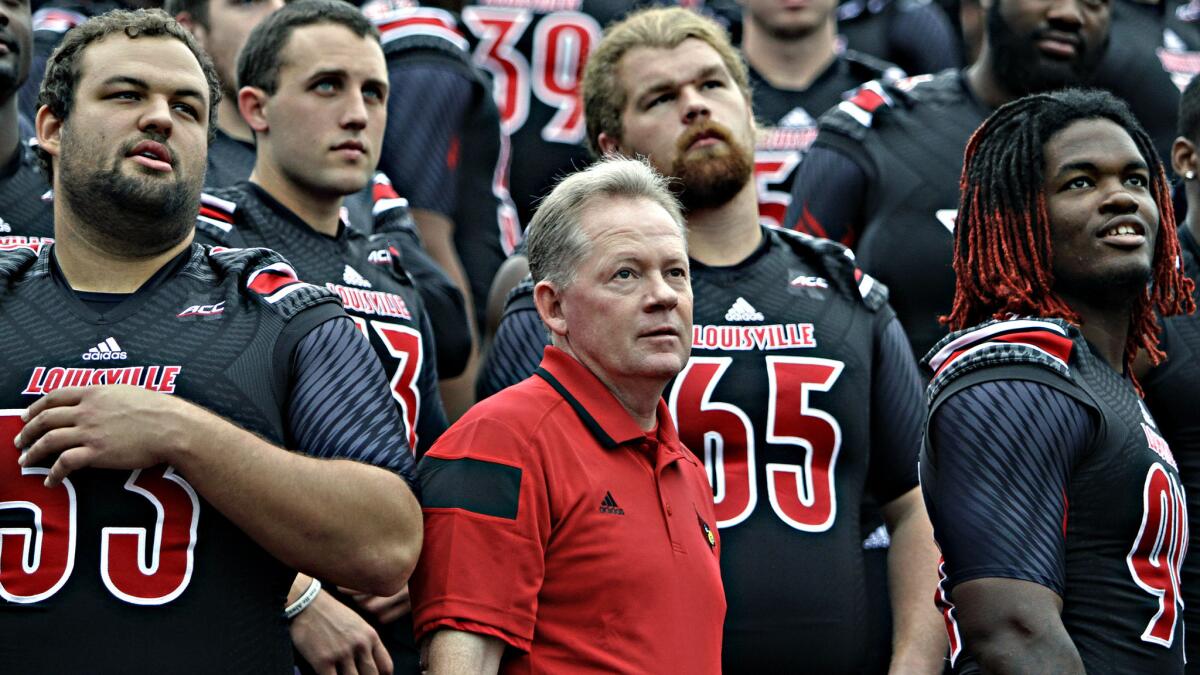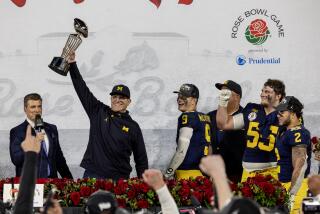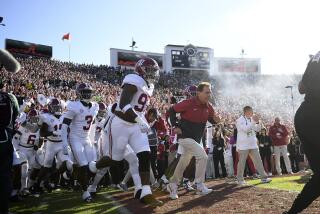College football’s game of conference realignment is finally ending

In the children’s game of musical chairs, the big loser is the kid who can’t find a seat when the music stops.
In college football’s game of musical chairs, the big loser is probably Connecticut.
Or, in the expanded game, toss in Boise State, Cincinnati, Central Florida and maybe Brigham Young.
After years of pillaging, plundering and back-stabbing — some of it during the season! — one of college football’s most distasteful chapters is happily ending.
Conference realignment, which dirtied up an entire decade starting with the Atlantic Coast Conference raiding the Big East of Miami, Virginia Tech and Boston College, is finally setting in wet cement.
The irony: It took the league that started it to stop it.
The ACC, which somewhat recklessly set off the dominoes when it frontally attacked the Big East, found itself vulnerable after it completed its redesign by adding Pittsburgh, Syracuse and Louisville.
The Big Ten countered by stealing Maryland from the ACC with maybe a thought of going after Georgia Tech. The Big 12, decimated by what the ACC started, might have had a retribution eye on Florida State and/or Clemson.
Last year, though, the ACC effectively stopped this nonsense by getting its members to consent to a “Grant of Rights” agreement. This means any school that leaves the ACC between now and 2026-27 must surrender all its television rights back to the league.
This is simply not ... going ... to ... happen.
Call this positive news the calm in a summer of storms.
There was a heavy price to pay for some, but the final contortions are almost complete.
The divide between the 65 schools in the Power Five conferences and everyone else, which existed before even if some didn’t want to believe it, has now been officially ratified.
The NCAA’s recent vote to cede the wealthy football leagues autonomy basically codified the divisional lines.
If you didn’t find a home before the music stopped, you got left behind.
How the shakedown shook out:
— The ACC finally completes its alignment box set by adding Louisville this year. The Cardinals bailed just in time as the Big East dismantled and reformed as a lesser union called the American Athletic Conference. Louisville joins Pittsburgh and Syracuse, which split the Big East last year.
The ACC is set with its 14-school alignment, championship game, and protected place in the new College Football Playoff.
— The Big Ten’s gurgling stops after adding Maryland from the ACC and Rutgers from the former Big East. The Big Ten now has 14 schools, divided into East and West divisions, a huge branding improvement from the fiasco of “Leaders” and “Legends” divisions.
Maryland and Rutgers join the more difficult East division, which includes Michigan State, Michigan, Ohio State and Penn State.
This is not Tom Harmon’s Big Ten. Michigan’s home schedule this year “features” Appalachian State, Miami (Ohio), Utah, Minnesota, Penn State, Indiana and Maryland, with Rutgers on the road.
The question is whether any football game at the Big House this year tops the 109,318 who attended an August soccer exhibition featuring Manchester United and Real Madrid.
— The Big 12 is, well, what it is, stuck at 10 teams after the midnight exodus of Texas A&M and Missouri to the Southeastern Conference.
Big 12 Commissioner Bob Bowlsby admits his league is “numerically challenged,” but also happy just to be alive. The upside: His league’s playing of a nine-game, round-robin schedule should produce the truest champion among the top leagues.
“I like our path to the championship,” Bowlsby said of the new four-team playoff. “I think the fact we play everybody in our league is a nuance that is not going to be lost on the selection committee.”
The downside for Power Five continuity is the Big 12 does not have enough schools to divide into leagues and play a championship game. The NCAA requires two divisions of at least six schools. Bowlsby would like to get a waiver from the NCAA to at least explore the possibility of playing a title game with only 10 teams.
It makes sense the Big 12 might eventually add two schools to match the number on its masthead. Connecticut, Cincinnati and Central Florida might want to see that happen.
— The Pac-12 and SEC are locked and loaded. The addition of Utah and Colorado has not yet significantly enhanced the Pac, but it did allow the league to split into divisions and make more money with a title game. Missouri and Texas A&M have, surprisingly, added football heft to the now 14-team SEC. The Pac-12, SEC and Big Ten are the bedrocks as they have never, in modern times, lost a team to another corporate raider.
The cutthroat expansion game left a clear-cut list of winners and losers:
Winner: Notre Dame. The Irish get the best of everything as they are allowed to remain football independent while playing five annual games against the ACC. Notre Dame also has contracted tie-ins to the Orange Bowl and ACC bowl roster. The Irish will be in the national title chase in years they can navigate an always challenging schedule (see: 2012).
Loser: Brigham Young? We could be wrong here, but the Cougars’ decision to go independent in football could be a reach in the playoff era. BYU has a special niche and following, but it is not Notre Dame.
Winners: Texas Christian, Utah, Rutgers. The first two escaped the Mountain West just before the iron curtain came down. TCU found a comfortable home in the power-league Big 12, while Utah hit the hallelujah highway with its last-second invite to the Pac-12 after the league’s plan to expand to 16 fell apart.
Rutgers, really, is Big Ten worthy? And they said pigs would fly first.
Loser: Connecticut (also Cincinnati, Central Florida). The Huskies are a former Big East football program that got boxed out, mainly because of politics and foot-dragging, from following Syracuse and Pitt to the ACC. Connecticut played in a Fiesta Bowl as recently as 2010, but all it got was a lousy T-shirt. The Big East began the Bowl Championship Series era in 1998 as one of six privileged football leagues. It has now been re-cobbled among the Gilligan’s Island “And the Rest” leagues along with the Mid-American, Sun Belt, Conference USA and the Mountain West.
American Athletic Commissioner Mike Aresco, at this summer’s media day, vowed to keep fighting for his league’s place in the new universe. The American conference is propped up now by Cincinnati, Connecticut, East Carolina and Central Florida, with Navy coming aboard in 2015.
Aresco said, “We will not take a back seat to anyone” and then quoted Abraham Lincoln, “Some see opportunity in every obstacle, while others see obstacles in every opportunity.”
Good luck with all that.
Winner: Chris Petersen. One of the nation’s top coaches jumped from Boise State just in time and caught a lifeboat to Washington. Petersen had to know the new rules would make it increasingly difficult to sustain Boise State’s excellence as the power conferences got richer at the expense of the poorer ones.
Loser: Boise State. The Broncos had an incredible run in a BCS system that was stacked against schools from mid-major conferences. In 2010, in fact, Boise State came within a missed field goal at Nevada from probably playing for the title.
Boise and San Diego State tried to make a football run for the Big East, but were forced back to the Mountain West after the Big East collapsed.
Gone, seemingly, are days when schools such as Boise will make national charges by defeating two power-league teams in nonconference and then running roughshod through the Western Athletic or Mountain West.
Not only will the selection committee have a more discerning eye toward conference strength, the old-school contenders are already beefing up their future schedules against other power-league schools.
One of the questions asked in a recent ESPN survey of coaches was whether schools from power leagues should even play schools from the non-power leagues.
Petersen checked the box for “no.”
He later backtracked and said that’s not what he meant.
There is no denying, however, that Petersen is playing in a different league now. There is also no denying that big shots have divided college football with only one remaining objective: conquer.
More to Read
Get our high school sports newsletter
Prep Rally is devoted to the SoCal high school sports experience, bringing you scores, stories and a behind-the-scenes look at what makes prep sports so popular.
You may occasionally receive promotional content from the Los Angeles Times.







